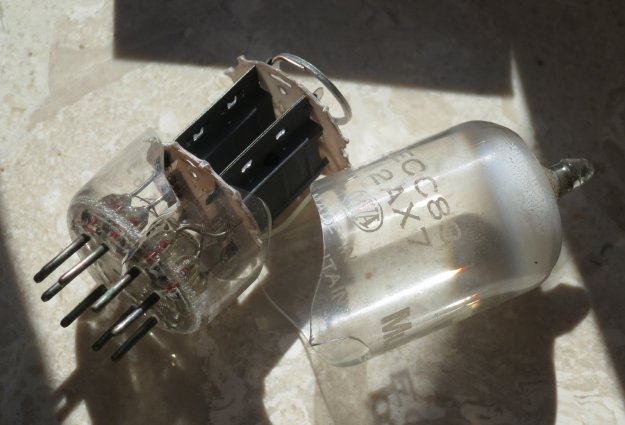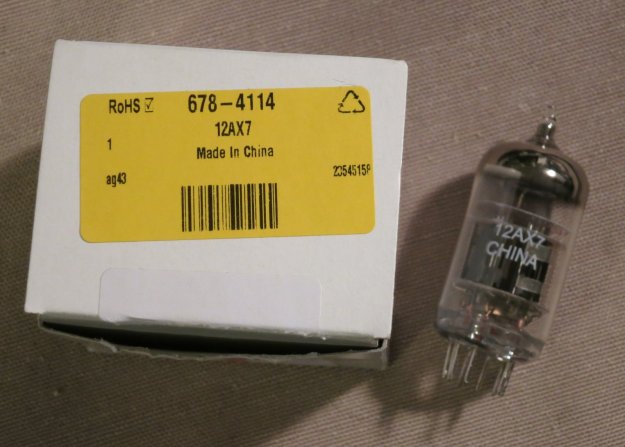Last year, I spent some time restoring my Tektronix 549 storage oscilloscope to full working order. The other day, I wanted to use it, so I switched it on and let it warm up. As I tried to use it, it was misbehaving: the controls all did strange things, the spot wouldn’t focus properly, the vertical amplifiers were all out of balance, it wouldn’t trigger properly, and it was generally very sick. It’s been moved all across the continent since it was restored, so I suppose I shouldn’t be surprised that something had gone awry.
I took the side panel off to make a few checks, but I didn’t have to look far. Down in the bottom of the machine I saw a valve with a white top. Here’s a picture: on the left, a normal, healthy valve. On the right, the one I saw.
The white top means one thing: the vacuum has escaped. There’s a patch of deposited metal (a barium compound, I think) on the inside of the valve whose job is to mop up any odd gas molecules by reacting with them. If serious amounts of air get in, it all turns to oxide and goes white.
I did the obvious thing and tried to wiggle the valve out of its socket.
Oops! How did that happen? The valve, a Mullard ECC83, had spontaneously broken. There’s no other physical damage to the scope, and it’s been moved about a bit but stored well. It’s a mystery. Still, at least it was easy to spot the fault.
The valve in question, V624, is the feedback amplifier for the -150V regulator in the scope’s power supply. The -150V rail is the reference for absolutely everything else in the scope, so if it’s acting up, there’ll be big trouble. And there was.
So, replace the valve. The ECC83, a double triode, was a common-or-garden cooking-variety valve in its day. Cheap and simple, useful in lots of places from radios to laboratory equipment. Trouble is, it was used in hi-fi equipment and guitar amplifiers which now have a cult following. Their fans will pay extraordinary money for valves with the right things written on them: which brand, which factory, what shape the glass is, are all highly prized. This little UK-made specimen from Mullard would probably be worth fifty quid or more if it was new in its box and not broken into two pieces. I’m not joking.
I didn’t want to pay the enormous price of a period replacement, so I was delighted to discover that RS Components sell new ECC83s for a very reasonable £4 or so. It’s amazing that they’re still made, but here’s one. A 12AX7 is the same thing as an ECC83 – American type number rather than European, but the same to all intents and purposes.
It’s Chinese of course. I think it’s made by Shuguang. Popped it in the scope, switched on, a slight tweak to the -150V adjustment and it’s back in action. Hooray. Here’s a gratuitous picture of some glowing valves.




Rs Components sells ECC83?
Really good news!
Thanks
Antonino